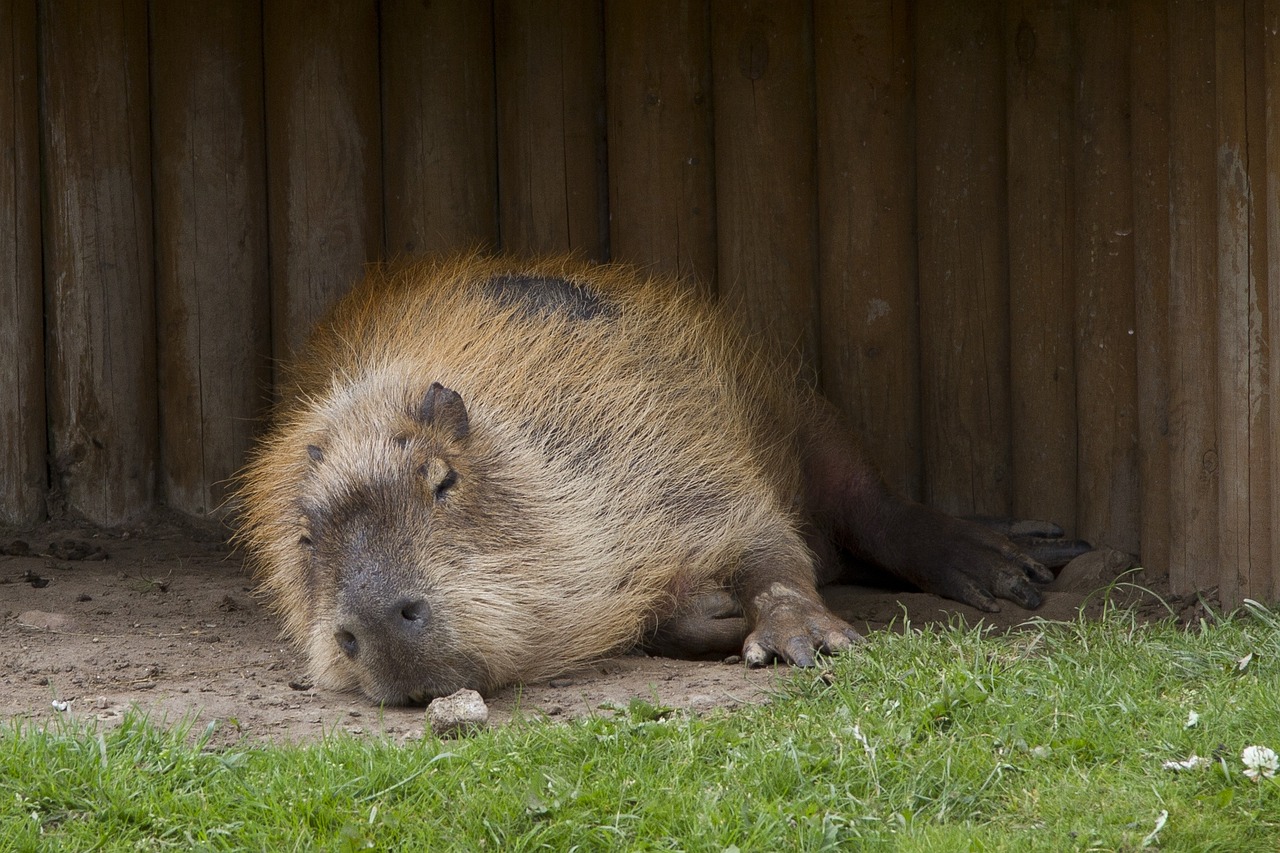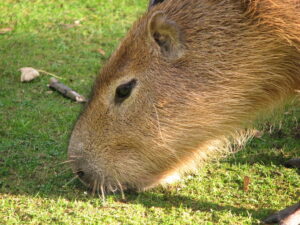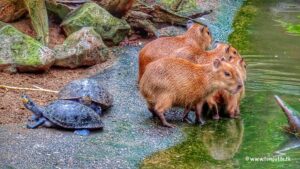The importance of a varied diet for capybaras
A balanced and varied diet is essential for the overall health and well-being of your capybara. These adorable creatures are herbivores and thrive on a diet that includes a wide range of plant-based foods. Providing your capybara with a diverse selection of fruits, vegetables, and other food items ensures that they receive the necessary nutrients and helps prevent nutritional deficiencies. Just like humans, capybaras can get bored with the same food every day. By adding variety and flavor to their meals, you can keep them interested and excited about their food.
Benefits of adding variety and flavor to your capybara’s meals
Adding variety and flavor to your capybara’s meals offers several benefits. Firstly, it helps prevent boredom and monotony in their diet. Imagine eating the same meal every day; it would quickly become dull and unappetizing. The same goes for capybaras. By introducing different flavors and textures, you can make their meals more enjoyable and enticing.
Secondly, a varied diet ensures that your capybara gets a wide range of essential nutrients. Different fruits and vegetables contain varying amounts of vitamins, minerals, and fiber. By offering a diverse selection, you can ensure that your capybara receives all the necessary nutrients for optimal health.
Lastly, providing a variety of foods can stimulate your capybara’s natural foraging instincts. In the wild, capybaras spend a significant amount of time searching for food. By offering a variety of food items, you can recreate this natural behavior in captivity, keeping your capybara mentally stimulated and engaged.
Common food items for capybaras
Capybaras have a unique digestive system that allows them to efficiently process plant materials. Their diet mainly consists of grasses, aquatic plants, and various fruits and vegetables. Here are some common food items that you can include in your capybara’s diet:
- Grasses: Capybaras love to graze on different types of grasses. Freshly cut grass or hay can be provided as a staple part of their diet.
- Leafy greens: Offer a variety of leafy greens such as lettuce, kale, spinach, and dandelion greens. These provide essential vitamins and minerals.
- Fruits: Capybaras enjoy a range of fruits, including apples, bananas, berries, and melons. Make sure to remove any seeds or pits that could be harmful.
- Vegetables: Carrots, cucumbers, zucchini, and bell peppers are great options for adding variety to your capybara’s meals.
- Aquatic plants: If you have access to aquatic plants like water hyacinth or water lettuce, these can be a nutritious addition to your capybara’s diet.

Remember to introduce new food items gradually to avoid digestive upset and monitor your capybara’s response to each new food.
Introducing new foods to your capybara’s diet
When introducing new foods to your capybara’s diet, it’s important to do so gradually. Start by offering small amounts of the new food and observe how your capybara responds. Introducing too many new foods at once can upset their digestive system.
Monitor your capybara for any signs of discomfort, such as diarrhea or bloating, after introducing a new food item. If any adverse reactions occur, remove the new food from their diet and consult with a veterinarian if necessary.
Additionally, it’s essential to research each food item before introducing it to your capybara. Some fruits and vegetables may be toxic to capybaras or have parts that are harmful, such as seeds or pits. Always remove any potential hazards before feeding them to your capybara.
Spices and herbs that are safe for capybaras
While capybaras primarily consume plant-based foods, you may be wondering if it’s safe to add spices and herbs to their meals. Generally, capybaras do not require spices to enhance their meals, as they are happy with the natural flavors of their food. However, if you’d like to experiment with adding a little flavor, there are a few safe options.
- Cilantro: Capybaras often enjoy the taste of cilantro. It can be sprinkled on their food to add a subtle flavor.
- Mint: Mint leaves can be offered occasionally as a refreshing treat for your capybara.
- Basil: Similar to mint, basil leaves can provide a mild flavor when added sparingly.
Remember to use spices and herbs sparingly, as capybaras have sensitive digestive systems. Always consult with a veterinarian before introducing any new spices or herbs to your capybara’s diet.
Recipes for flavorful capybara meals
Here are a couple of simple recipes to add flavor to your capybara’s meals:
Capybara Salad Delight
Ingredients:
- A mix of leafy greens (kale, lettuce, spinach)
- Chopped carrots
- Sliced cucumbers
- Diced bell peppers
Instructions:
- Combine all the ingredients in a bowl.
- Toss the ingredients together to ensure an even distribution.
- Serve the salad to your capybara as a refreshing and nutritious meal.

Fruity Capybara Smoothie
Ingredients:
- A blend of fruits (apples, bananas, berries)
- A handful of fresh mint leaves (optional)
Instructions:
- Cut the fruits into small pieces.
- Add the fruits and mint leaves to a blender.
- Blend until smooth.
- Pour the smoothie into a bowl and serve it to your capybara as a delicious treat.
Remember to remove any seeds or pits from the fruits before blending or serving them to your capybara.
Tips for maintaining a balanced diet for your capybara
Maintaining a balanced diet for your capybara is crucial for their overall health. Here are some tips to ensure they receive the necessary nutrients:
- Consult with a veterinarian: Seek advice from a veterinarian who specializes in exotic animals to create a suitable diet plan for your capybara.
- Monitor portion sizes: Capybaras have specific dietary requirements, and overfeeding can lead to obesity and other health issues. Follow the recommended portion sizes for each food item.
- Rotate food items: Offer a rotation of different fruits, vegetables, and greens to provide a variety of nutrients.
- Provide fresh water: Ensure your capybara always has access to clean and fresh water for hydration.
- Avoid processed foods: Stick to natural and fresh food items, as processed foods may contain harmful additives.
Foods to avoid or limit in your capybara’s diet
While capybaras can consume a wide range of fruits and vegetables, there are a few items to avoid or limit in their diet:
- Citrus fruits: Citrus fruits, such as oranges and lemons, can cause digestive upset in capybaras. It’s best to avoid these fruits altogether.
- Avocado: Avocado contains a toxin called persin, which can be harmful to capybaras. Avoid feeding them avocado or any food products containing avocado.
- High-sugar fruits: Fruits like grapes and raisins have high sugar content and should be fed in moderation.
- Onions and garlic: Onions and garlic contain compounds that can be toxic to capybaras. Avoid feeding them any foods that contain these ingredients.
Creating a meal plan for your capybara
To ensure your capybara receives a balanced diet, it can be helpful to create a meal plan. Here’s a sample meal plan to get you started:
- Breakfast: A mix of leafy greens and grasses
- Lunch: Chopped carrots, cucumbers, and bell peppers
- Dinner: A blend of fruits with a side of fresh mint leaves
- Snacks: Occasional treats such as watermelon slices or dandelion greens
Remember to adjust the portion sizes based on your capybara’s age, size, and activity level. Regularly monitor their weight and consult with a veterinarian for any necessary adjustments.
Conclusion
Enhancing your capybara’s diet with variety and flavor is an excellent way to keep them happy and healthy. By offering a diverse selection of fruits, vegetables, and herbs, you can provide your capybara with the necessary nutrients while keeping their meals interesting and enjoyable. Remember to introduce new foods gradually, avoid any potentially harmful items, and consult with a veterinarian for personalized dietary recommendations. With a balanced and flavorful diet, your capybara will thrive and live a long, happy life.




